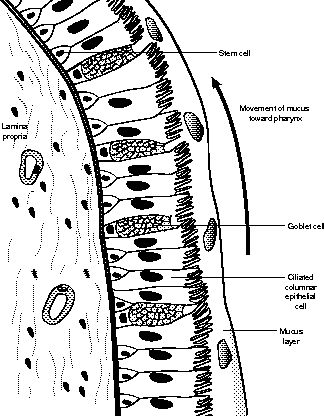Anatomy and Physiology: More Than Just a Pipe
More Than Just a Pipe
Once again, you die rather quickly from the lack of oxygen. Oxygen enables you to get 18 times more energy from the breakdown of glucose than doing so without oxygen. Food is the source of energy, and without oxygen, you can't get enough energy; so when you suffocate, you are in effect starving your cells to death! Since your brain requires more energy at rest than the rest of your body, it is the first organ to die. Obviously the exchange of gases is critical, and so your body emphasizes this point by making the trachea stay open through a series of rings of tracheal cartilage.
Remember when I talked about the dust floating in the air that gets trapped by the mucus in your nose? Only so much of that dust gets trapped in the nose, and if you breathe through your mouth, little or none gets trapped. Luckily the trachea is one long mucus factory. Remember from the tissues section, mucous is produced by the Golgi apparatus, which are in very large quantity in goblet cells.
I always liked the name goblet cells, particularly knowing the contents of mucus. Mucus is made of water, proteins, and polysaccharides; that's almost a balanced meal! You could probably survive on a bucket of mucus a day! But I digress …. These tracheal goblet cells are found in between groups of ciliated columnar epithelial cells. After the dust gets caught in the mucus, these tiny balls of mucus and dust are propelled upward, allowing them to ultimately travel down the esophagus (see Figure 13.5).

Figure 13.5Dust in the air you breathe is trapped by mucus, and is then moved upward toward the pharynx by cilia on the epithelial cells of the mucous membrane.
A Different Kind of Tree
Our old friend surface area is coming into play again! Our bodies are so large that there is no way for the skin to absorb enough oxygen to keep you alive. The first place for increasing the surface area, the bronchi, also serves another function: to divide the airflow to the two lungs. Beyond that, the airway in each lung continues to divide and divide, greatly increasing the surface area. This ever-increasing division of the airway is known as the bronchial tree.
Throughout all this, because of the need to keep the respiratory surface moist (a necessity for gas exchange), the bronchial walls contain goblet cells, which perform the same role as in the trachea. These goblet cells go into overdrive whenever you get a bacterial infection in your lungs. This inflammation of the bronchial tubes, complete with the excess mucus production, is called bronchitis.
Respiratory Portion
The lungs would be useless without the heart. Remember, never think about systems in isolation! The respiratory surface is entirely focused on exchange of gases with the cardiovascular system. For good measure, there are even some white blood cells called alveolar macrophages, hanging around the site of gas exchange (the alveoli) to clean up any foreign material! As I explored in The Heart, the four chambers of the heart are dedicated to keeping deoxygenated blood from the systemic circuit (in the right atrium and ventricle) separate from the oxygenated blood from the pulmonary circuit (in the left atrium and ventricle).
The smallest portion of the respiratory system is the alveolus. There are so many alveoli that the total surface area is equal to the size of a doubles tennis court (see Figure 13.6). Of course, we could also just have evolved as a large, flat pancake, but it would be awfully hard to go dancing! Every alveolus is surrounded by capillaries, and it is this junction where the actual gas exchange occurs. Two things make this possible in every alveolus. One is the moist respiratory surface; gases cannot diffuse through a membrane unless there is water present. The other is directly related to the structure of the capillary and the alveolus. The walls of each of these structures are only one flat cell thick; these incredibly thin walls allow the gases to move freely across the divide. These walls also allow water from the blood to be exhaled, as anyone has seen walking on a cold winter's morning. In a similar sense, any alcohol a person imbibes will travel through the bloodstream, only to diffuse through those thin walls to be detected on the breath!

Figure 13.6The alveoli are the location of the gas exchange between the air and the bloodstream. (LifeART©1989-2001, Lippincott Williams & Wilkins)

Excerpted from The Complete Idiot's Guide to Anatomy and Physiology © 2004 by Michael J. Vieira Lazaroff. All rights reserved including the right of reproduction in whole or in part in any form. Used by arrangement with Alpha Books, a member of Penguin Group (USA) Inc.
To order this book direct from the publisher, visit the Penguin USA website or call 1-800-253-6476. You can also purchase this book at Amazon.com and Barnes & Noble.







